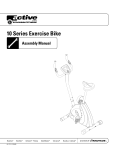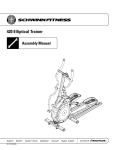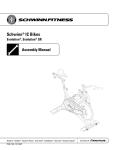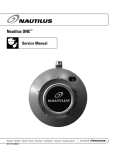Download Cateye 213 Recumbent Bike Service manual
Transcript
SCHWINN RETAIL BIKE Service Manual This manual applies to the following models: 101 102 103 112 113 122 123 126 130 131 201 202 203 206 212 213 223 226 230 PN 001-7082 rev B (03/07) SERVICE MANUAL CONTENTS Table of Contents Troubleshooting .................................................................2 Important Contact Numbers ..............................................11 TROUBLESHOOTING Basic Troubleshooting 1. Problem: No display/partial display/unit will not turn on Solution: A. Make sure unit is plugged into a functioning wall outlet. B. Check power connection at front (recumbent) or rear (upright) of the unit. Connection should be secure and undamaged. Replace adapter or connection at unit if either are damaged. C. Check data cable integrity. All wires in cable should be intact. If any are visibly crimped or cut, replace cable. D. Check data cable connections/orientation. Insure cable is connected securely and oriented properly. Small latch on connector should line up and snap into place. E. Check console display for damage. Check for visual sign that console display is cracked or otherwise damaged. Replace console if damaged. F. Check console display. If console only has partial display and all connections are OK, replace computer. Advanced Troubleshooting If above steps do not resolve proceed to advanced troubleshooting, problem A1. 2. Problem: Unit operates but Contact HR not displayed Solution: Note: Sensors may have difficulty with dried out or calloused hands. A conductive electrode cream such as “Signa Crème” or “Buh-Bump” can help make better conduct. These are available on the web or at medical or some larger fitness stores. A. Ensure hands are centered on HR sensors. Hands must be kept still with relatively equal pressure applied to each side. B. Check HR cable connection at console. Ensure cable is connected securely to console. C. Check HR cable box connection. Ensure cables from handlebars and cable to console are secure and undamaged. Some models may require seat back be raised to access cable box. If the above tests reveal no problems, replace the handlebars. TROUBLESHOOTING Basic Troubleshooting TROUBLESHOOTING Basic Troubleshooting 3. Problem: Unit operates but Telemetric (if equipped) HR not displayed Solution: A. Verify you are working with a model that features telemetric HR. Most models do not have this feature. B. Check chest strap. Strap should be “Polar” compatible. Make sure strap is directly against skin and contact area is moist. C. Check for interference. Try moving unit away from sources of interference (TV, Microwave, etc.). If interference is eliminated and HR still does not function, replace strap and console. 4. Problem: Console displays “E2” error code Solution: A. Check data cable integrity. All wires in cable should be intact. If any are crimped or cut, replace cable. B. Check data cable connections/orientation. Insure cable is connected securely and oriented properly. Small latch on connector should line up and snap into place. If the above tests reveal no problems, replace the DC Motor. TROUBLESHOOTING Basic Troubleshooting 5. Problem: No speed/RPM reading Solution: A. Check data cable integrity. All wires in cable should be intact. If any are crimped or cut, replace cable. B. Check data cable connections/orientation. Ensure cable is connected securely and oriented properly. Small latch on connector should line up and snap into place. C. Check magnet position (requires shroud removal). Magnet should be in place on flywheel. If no magnet present, replace flywheel or entire base unit if customer unable to replace flywheel. D. Check RPM Sensor (requires shroud removal). RPM sensor should be aligned with magnet and connected to data cable. Re-align sensor if necessary; replace if any damage to sensor or connecting wire. TROUBLESHOOTING Basic Troubleshooting 6. Problem: Console shuts off (enters sleep mode) while in use Solution: A. Check data cable integrity. All wires in cable should be intact. If any are crimped or cut, replace cable. B. Check data cable connections/orientation. Insure cable is connected securely and oriented properly. Small latch on connector should line up and snap into place. C. Reset Machine (if equipped with reset button). Unplug unit from electrical outlet for 3 minutes. Reconnect to outlet and after console powers up press “reset”. D. Check magnet position (requires shroud removal). Magnet should be in place on flywheel. If no magnet present, replace flywheel or entire base unit. E. Check RPM Sensor (requires shroud removal). RPM sensor should be aligned with magnet and connected to data cable. Re-align sensor if necessary, replace if any damage to sensor or connecting wire. TROUBLESHOOTING Basic Troubleshooting 7. Problem: Unit rocks/does not sit level Solution: A. Check leveler adjustment. Leveling feet may be turned in or out to level bike. B. Check surface under unit. Adjustment may not be able to compensate for extremely uneven surfaces. Move bike to level area. 8. Problem: Pedals loose/unit difficult to pedal Solution: A. Check pedal to crank connection. Pedal should be tightened securely to crank. Insure connection is not cross-threaded. B. Check crank to axle connection. Crank should be tightened securely to axle. Be sure cranks are connected at 180 degrees from each other. 9. Problem: Seat post feels loose Solution: A. Insure adjustment pin is locked into one of the seat post adjustment holes. B. Insure knob is securely tightened. TROUBLESHOOTING advanced Troubleshooting A1. Problem: No display/Unit will not turn on Solution: A. Check A/C adapter. Using a volt meter check the voltage output from the adapter. With positive lead on inside of connector and negative lead on outside, voltage should be within 9-14VDC. If voltage is outside this range, replace adapter. If voltage is OK, check computer. B. Disconnect upper wiring harness from back of computer, and while power is supplied to machine, use a volt meter to check that voltage is reaching computer. Voltage between pins 1 (purple) and 3 (pink), (Figure A), should be within 9-14VDC. If voltage is within range, replace computer. If not, check upper wiring harness. Figure A C. Remove console mast and disconnect upper wiring harness from lower wiring harness. Test output voltage at lower harness using pins 1 and 3, as above. If voltage is now present between 9-14VDC, replace upper wiring harness. If not, check power plug wire. D. Remove the shroud half that has the power plug mounted into it. Disconnect power plug wire from resistance motor wiring harness. Test voltage output of power plug wire. If no voltage present, replace power plug wire. If voltage is within 9-14VDC, replace DC MOTOR (includes lower wiring). A2. Problem: Resistance does not change (assumes unit powers up and otherwise functions normally) Solution: A. Check computer wire connections and continuity. Replace any damaged wires. If wire is OK, check servo motor. B. Check servo motor. Remove shrouds. Test voltage at servo motor red and black wires, (Figure B). Voltage should be approximately 2.5VDC while either the UP or DOWN console resistance buttons are pressed. If voltage is correct but motor does not turn, replace DC MOTOR (includes lower wiring). If motor turns but magnet arm assembly does not move, check and secure the mechanical components. Replace any damaged components. Figure B TROUBLESHOOTING advanced Troubleshooting TROUBLESHOOTING advanced Troubleshooting A3. Problem: Drive train click/tick noise once per full crank revolution Solution: A. Check bottom bracket. Remove pedals and rotate crank. If sound persists, replace bottom bracket. If sound is eliminated, check pedals. B. Check pedals. Replace pedals and make sure they are tightened securely. Rotate crank. If sound persists, replace pedals. A4. Problem: Noise multiple times per revolution or once per 1.5 revolution. Solution: A. Check belt. Remove shrouds. Visually inspect belt for irregularity while slowly rotating pedals. Replace if damaged. B. Check tensioner spring, pulley. Check the belt tensioner spring is in place and functional. If tensioner is in place but is not providing enough tension to prevent belt from slipping, replace tension spring, (Figure C). C. Check flywheel hub. Slowly rotate crank arms and listen closely for sound from flywheel hub. If sound is present, replace the flywheel. Figure C 10 If you need assistance, please have both the serial number of your machine and the date of purchase available when you contact the appropriate Nautilus office listed below. OFFICES IN THE UNITED STATES: E-mail: [email protected] • NAUTILUS INNOVATION CENTER Nautilus, Inc. 1886 Prairie Way Louisville, Colorado, USA 80027 INTERNATIONAL OFFICES: For technical assistance and a list of distributors in your area, please call or fax one of the following numbers. • INTERNATIONAL CUSTOMER SERVICE: Nautilus International S.A. Rue Jean Prouvé 6 1762 Givisiez / Switzerland Tel: + 41-26-460-77-77 Fax: + 41-26-460-77-70 Email: [email protected] Phone: 800-NAUTILUS (800-6288458) Fax: 800-898-9410 • TECHNICAL/CUSTOMER SERVICE Nautilus, Inc. World Headquarters 16400 SE Nautilus Drive Vancouver, Washington, USA 98683 Phone: 800-NAUTILUS (800-6288458) Fax: 877-686-6466 • CORPORATE HEADQUARTERS Nautilus, Inc. World Headquarters 16400 SE Nautilus Drive Vancouver, Washington, USA 98683 Phone: 800-NAUTILUS (800-6288458) INTERNATIONAL OFFICES: • SWITZERLAND OFFICE Nautilus Switzerland S.A. Tel: + 41-26-460-77-66 Fax: + 41-26-460-77-60 • GERMANY and AUSTRIA OFFICE Nautilus GmbH Tel: +49 2203/20 20-0 Fax: +49 2203/20 20-45 45 • ITALY OFFICE Nautilus Italy s.r.l. Tel: +39-051-664-6201 Fax: +39-051-664-7461 • UNITED KINGDOM OFFICE Nautilus UK Ltd. Tel: +44-1908-267-345 Fax: +44-1908-267-346 • CHINA OFFICE Nautilus Representative Office Tel: +86-21-523-707-00 Fax: +86-21-523-707-09 11 IMPORTANT CONTACT NUMBERS IMPORTANT CONTACT NUMBERS





















